#iucn
Text
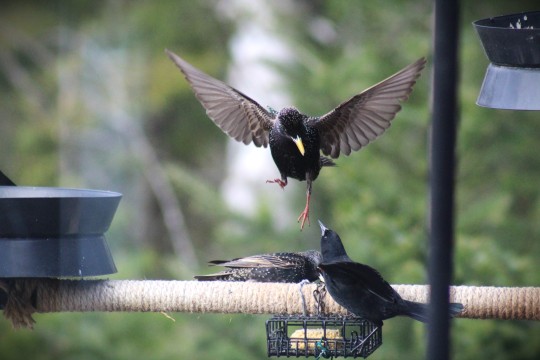


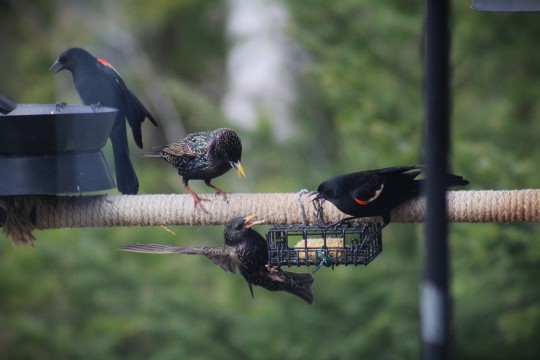




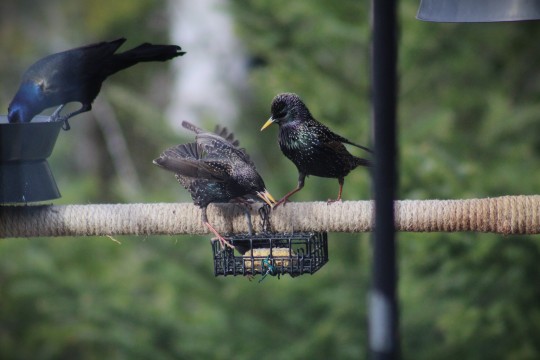


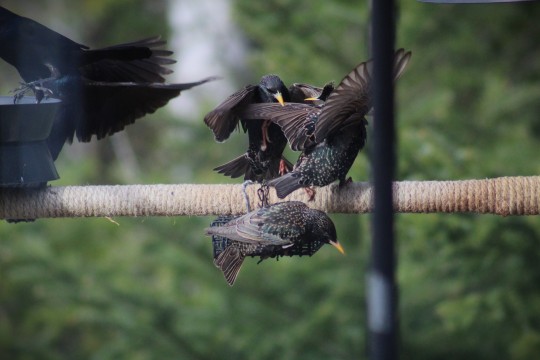

#EuropeanStarling
So this morning I captured on camera (thru my bay window) some European Starlings at their best … just for the fun of it. Here they are Terri
@BenAdrienProulx
April 19th, 2024.
#European Starling#Wildlife Need Protection#IUCN#International Union for Conservation of Nature#ECCC#Environment and Climate Change Canada#FeederWatch#Count Feeder Birds for Science#NCC#Nature Conservancy of Canada#Nature Photography#Nature Canada#Wild Bird Photography#Wildlife Photography#Animal Photography#Mountainous Parts of the Northern Hemisphere#Canada
137 notes
·
View notes
Text

This is a metal snail (Volcano Snail) that lives on underwater volcano vents in the Indian Ocean. Its shell and scaly feet both are armoured with layers of iron, making it the only animal to incorporate iron sulfide into its skeleton 🐌
📷: Dr Chong Chen/IUCN
#snails#snail life#snail#iron snail#oceans#indian ocean#science#news#research#biodiversity#iucn#iucn red list#science acumen#wildlife biologist#marine biology#biology#volcano#active volcano#amazing
4K notes
·
View notes
Text
Welcome to the first IUCN Wednesday! Today we’re going to be talking about one of my favorite cats the clouded leopard

(Image description: a clouded leopard sitting on a branch looking in the direction of the camera)
They are a small cat only weighing up to 51 lbs, they are mainly arboreal (the best climbers among cats) and hunt macaque, hog deer, slow loris, and other small vertebrates.
A fun fact about these guys are that they are often referred to as “modern-day sabertooth cats” and you can see why

(Image description: clouded leopard yawning, showing off their teeth)
Their canine teeth unusually long for their body size (the upper canines being about 3x longer than the basal width of its socket).
Unfortunately life hasn’t been kind to these guys, most of their subspecies are classified as vulnerable, with the Sumatran and Bornean classified as endangered. The Formosan subspecies has actually been classified as extinct since 2012 though in 20-8 there were two alleged sightings but these can’t be confirmed.
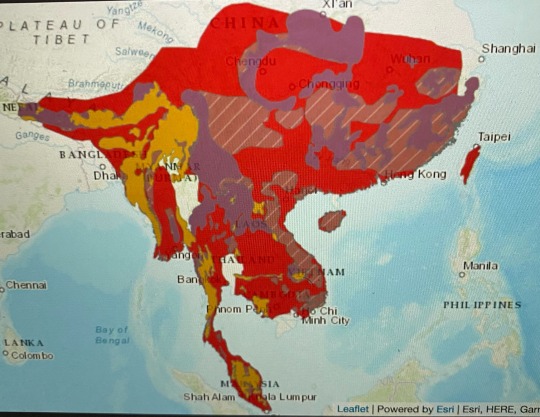

(Image description 1: a map of the current and past geographical range of the clouded leopard. Image description 2: a key to the previous map listing extant, possibly extant, possibly extinct, extinct)
(All subspecies are being included here)
This is the IUCNs most recent geographical range based off of the last species assessment from November 2020. The estimated number of mature individuals ranges from 3700-5580 and the population is decreasing.
Their biggest threats are of course people from human development to agriculture to transportation (roads and railways) to how we modify the environment (dams). That doesn’t even include the international pet trade or being killed for their pelts or body parts for medicine. Or because they’re seen as a threat (just look at how people over reacted when Nova was let out at the Dallas zoo).
These guys are really amazing (more so than i can say in a single post) so i encourage you to do your own research and hopefully fall in love with them like i have.
70 notes
·
View notes
Photo
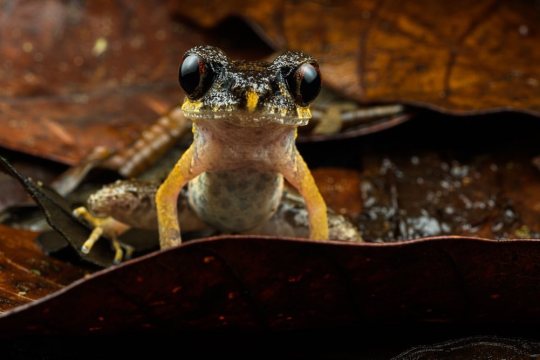
A beautiful and Near Threatened species endemic to Northern Borneo: the slender litter frog (Leptolalax gracilis). It lives in tropical moist forest close to little streams and its population is decreasing mainly because of habitat loss. #leptolalax #megophrydae #picoftheday #herping #herpingtheglobe #conservation #iucn #iucnredlist #amphibianconservation #borneo #malaysia @ilcp_photographers https://www.instagram.com/p/ChG1rNGPzk8/?igshid=NGJjMDIxMWI=
#leptolalax#megophrydae#picoftheday#herping#herpingtheglobe#conservation#iucn#iucnredlist#amphibianconservation#borneo#malaysia
203 notes
·
View notes
Text
1/3 of shark species (sharks,chimeras,rats ) are classified as critically endangered (CR) or vulnerable (VU). This means that they are facing the risk extinction.
3/4 of oceanic species are faced with extinction.
This could be because more than 200 million sharks are killed annually.
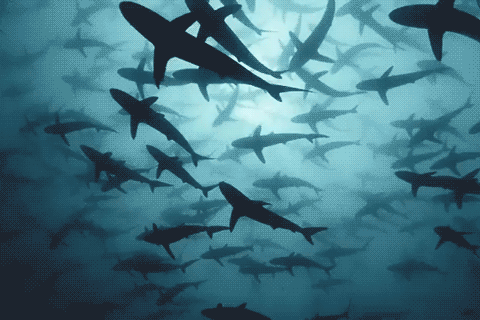
Current measures of protection seem not to be working (legislation gear bans, catch quotas).
A good number of shark species are highly migratory. This makes it much more harder to protect them as laws protecting endangered species are not upheld in all countries.
So the issue seems to be local rather than international as sharks do not have boundaries as we do.
Some treaties of interest to shark conservation include:
Convention on International Trade in Endangered Species of Wild Fauna and Flora (CITES)- this treaty is important for banning the trade of endangered animals or their parts eg. elephant tusks, rhino horns,shark fins.
The Convention on Migratory Species of Wild Animals (CMS)-this aims to protect all migrating animal species such as whales, sharks,salmons,wildebeasts etc.
Only three species of sharks are protected globally:
The great white

The basking shark
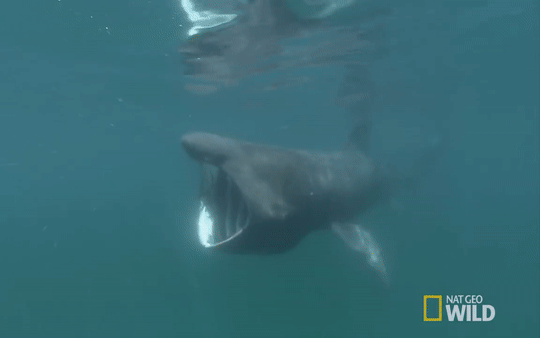
The whale shark
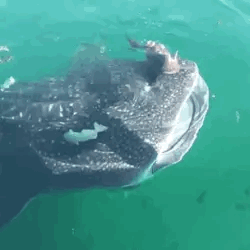
One thing that has seemed to work has been the creation of parks/sanctuaries for marine life. In these areas , shark fishing is prohibited. This is a good approach in the long term but may not work in the long run as sharks are very mobile ( who says a fisherman may not be waiting just beyond the boundary).
#shark#ghostfish#rays#ocean#conservation#nature#marine life#sea#great white shark#basking shark#whale shark#iucn#extinction
52 notes
·
View notes
Text

I drew this back in the fall of 2020. It depicts a Vancouver Island Marmot (Marmota vancouverenis) and her pup. Vancouver Island Marmots are Critically Endangered with approximately 90 mature individuals remaining. You can learn more about them here: https://www.iucnredlist.org/species/12828/22259184
#animals#marmots#Vancouver Island#baby animals#IUCN#iucn red list#critically endangered#pnw#pnw animals#pacific northwest
7 notes
·
View notes
Text
youtube
Apakah Harimau jawa Belum Punah?????
Oke kawan, di pagi yang cerah ini saya menemukan suatu video yang membuat saya berpikir.
Apakah benar Harimau Jawa benar-benar punah pada tahun 1980 an??
dan menurut sumber yang saya peroleh harimau jawa terakhir terlihat di Taman Nasional Meru Betiri.
Tuliskan pendapatmu setelah melihat video di atas.
2 notes
·
View notes
Text


© LIA 2023
Cattolotl (CR)
Axolotls (Ambystoma mexicanum) may be pretty popular pets and internet stars with their silly antics and strange appearance but unfortunately in the wild, they are now critically endangered. They remain at only three sites and their population is estimated to be
between 50 to 1000 individuals. Their decline has been mainly attributed to the increasing urbanisation of Mexico City resulting in pollution and desiccation of their aquatic home. Previous collection for the international pet trade, local consumption, and the introduction of invasive carp and tilapia have also threatened the species.
Find out more on the IUCN RedList website.
#catto#illustration#cat#alien#monster#digital illustration#art#axolotl#pink#iucnredlist#iucn#iucn red list#endangered species#endangered#critically endangered
3 notes
·
View notes
Text

It's December 4th, 🐆 International Cheetah Day! On this day in 1976, a Cheetah cub named Khayam was born at Wildlife Safari, in Winston, Oregon, USA. Doctor Laurie Marker raised Khayam from a cub until its death in 1986. In 2010, she designated December 4th as International Cheetah Day, and the event has been growing by leaps and bounds ever since.
Cheetahs used to roam everywhere from the southern tip of India across the Arabian Peninsula to the whole of Africa, but the 7,000 remaining Cheetahs are now limited to small fragmented areas in Africa and Iran.
Cheetahs are carnivores and feed mostly on small antelope like gazelle and impala. They usually chase down their prey and then, as all big cats do, clamp down on the captured animal’s throat until it suffocates.
Cheetahs have “tear marks” that run from the inside corners of their eyes down to the outside edges of their lips to help deflect sun glare from their eyes.
A Cheetah cub has a mantle of long, tall hair on its back. This helps the cub blend into the tall grass while making it look much like a dangerous Honey Badger – an animal even lions and hyenas think twice about messing with.
Cheetahs have long, muscular tails that help them keep their balance when they're running fast. The Cheetah is the world’s fastest land animal – it can run 110 kph (70 mph) – but it can't outrun extinction. The International Union for Conservation of Nature (IUCN) lists the Cheetah's current status as "vulnerable." Our planet's Cheetah population has declined by 90% over the past 100 years, and I suspect it won't be long before they’re declared "endangered." Can you imagine our world without Cheetahs? Please help save them if you can. ☮️ Peace… Jamiese of Pixoplanet
#Jamiese#Pixoplanet#IUCN#Vulnerable Species#Endangered Species#Extinction#international cheetah day#cheetah#wildlife#wildlife photography#africa#animals#intl cheetah day#nature#save the cheetah#bigcats#animal#african wildlife photography#conservation#african wildlife#nature photography#cheetahs#cheetah day#save cheetahs#cheetah conservation fund#safari photography#africa safari#wildlife conservation#masai mara national park#masai mara
2 notes
·
View notes
Text
Why the global water crisis needs local solutions?
Water security is under threat as competing socio-economic and environmental priorities make sustainably managing this finite resource difficult. Some suggest applying the global principles of climate change mitigation, but volumetric targets or offsets ignore the regional factors that drive the water crisis. Instead solutions must be local and account for the ecology of individual watersheds and how communities use resources, write Dr Derek Vollmer and Dr Ian Harrison of Conservation International, an IUCN Member organisation.
7 notes
·
View notes
Text
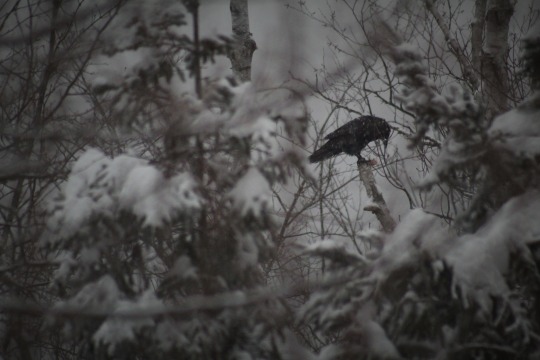

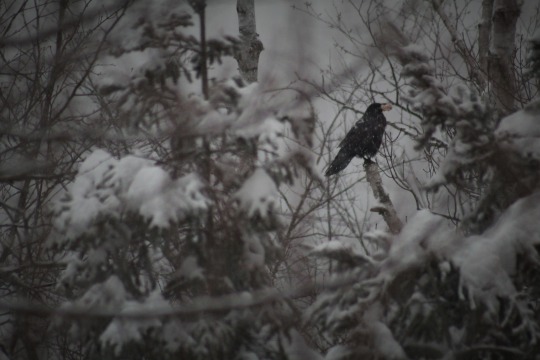
#TheDayAfter
At dawn after a snowstorm, a Raven is about to take off with his breakfast; a chicken leg.
@BenAdrienProulx
January 10th, 2024
#The Day After#Northern Raven#Raven#Wild Bird#Wildlife Photography#Raw Nature#Nature Core#Nature Gothic#Chicken Leg#SnowStorm#Nature Photography#Nature Canada#Wild Bird Photography#Animal Photography#Bird Watching#Bird Photography#Bird life#Bird Lover#eBirders#IUCN#International Union for Conservation of Nature#NCC#Nature Conservancy of Canada#ECCC#Environment and Climate Change Canada#Mountainous Parts of the Northern Hemisphere#Canada
548 notes
·
View notes
Text


#fungi#austropaxillus statuum#mycology#patagonia#nothofagaceae host trees#giuliana furci#iucn#fungal conservation
2 notes
·
View notes
Text
Ok since my last one of these suddenly got a lot of traffic and it’s a Wednesday, welcome back to IUCN Wednesday!
This was supposed to be about blue whales but some new information just came out which swayed me to these fluff balls

(Image description: An Amur leopard standing in the snow looking towards the camera)
The critically endangered Amur leopard, a fluffy and rare subspecies of leopard found in China and Russia. Their scientific name is Panthera pardus orientalis. They weight between 70 and 105 pounds and live between 10-15 years in the wild and 20 in captivity.

(Image description: side view of an Amur leopard walking along a log in a snowy forest)
These powerful cats take down prey three times their size, namely preying on boar and deer. Like their cousins, they often hide their kills in trees to return later.

(Image description: Current range map of Amur leopards, showing the extinct range stretching from Korea into China and eastern Russia, with a small area on the China/Russia border along the coast showing their extant range)
Unfortunately, life hasn’t been kind to these cats, severe habitat destruction and degradation had their extant range and population plummet. In the early 2000s there was only an estimated 30 individuals left in the wild.
While the wild population has increased to an estimated 100 individuals in recent years (180 in captivity) due to conservation efforts, they are still suffering due to climate change shrinking suitable habitat. Plus inbreeding, disease, and genetic bottleneck from the small population size.
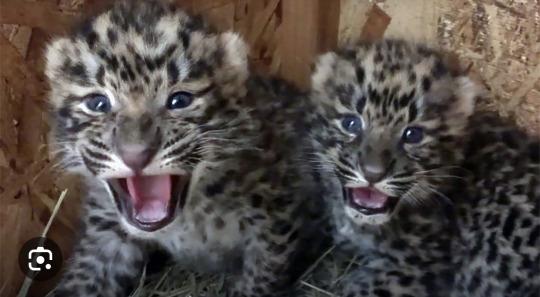
(Image description: two amur leopard cub with their mouths open looking towards the camera)
Not all hope is lost however, these two angry fluff balls were born in May at Cheyenne mountain zoo and they make up two percent of the wild population. They are vitally important genetically, and are doing extremely well. Today it was just announced that they are both males, i highly recommended checking out cmz YouTube for adorable videos.
Conservation efforts are continuing, both in their native habitat and throughout the world to boost genetic diversity and population numbers. So if you want to help the widely known rarest big cat on earth, maybe check out your local (aza accredited/participating in the species survival program) zoo.
9 notes
·
View notes
Text
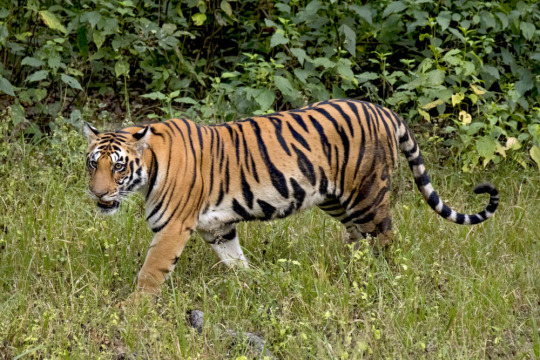
The number of endangered tigers around the world is 40 percent higher than previously thought, according to new data from the International Union for Conservation of Nature (IUCN).
The group estimates that there are between 3,726 and 5,578 tigers in the wild, up significantly from its last assessment in 2015. The new total is a reflection of both improved monitoring and the impact of conservation efforts.
“Although tigers are still endangered, their populations appear to be stable or increasing,” Jon Paul Rodríguez, chair of the IUCN Species Survival Commission, said in a statement. “We need to learn from these conservation successes, share them with the public, and increase our investment in evidence-based conservation action.”
#tiger#tigers#conservation#International Union for Conservation of Nature#IUCN#part of it is better monitoring of the tigers#BUT PART OF IT IS CHANGE FOR THE BETTER#oh brave new world
6 notes
·
View notes
Text
Manta rays are a symbol of respect and tenacity.
This is because they easily adapt to different pressures and depths in the oceans.
Oceanic manta rays have few natural predators as they are very large and fast .The main ones are large sharks and dolphins.
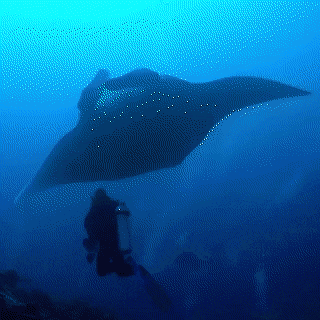
Manta rays have a late sexual maturity. Males become sexual mature when their discs are 4m and females when the discs are about 5m wide .

The have a long gestation period and (12-13months ) and normally have one pup. With threats such as overfishing, this makes it difficult for their populations to bounce back easily.
Their gills are highly valued in the Chinese medicine market and are used to make a tonic that boosts one’s immunity.

They are officially listed as endangered by the IUCN.
Other threats they face include:
Pollution ( manta rays are filter feeder and they may be consuming micro plastics which are known to carry persistent organic chemicals such as DDT’s)
Boat collisions
Bycatch(they get caught in fishing gear especially in shallow waters)
TikTok and instagram : @lastingoceans
#sea life#manta ray#ocean#conservation#nature#marine life#marine biology#iucn#animals#sea#sharks#underwater
11 notes
·
View notes
Text
A global ecological signal of extinction risk in terrestrial vertebrates

https://conbio.onlinelibrary.wiley.com/doi/10.1111/cobi.13852
#study#studyblr#aslzoology#asl zoology#zoology articles#zoology#conservation biology#extinction#climate change#sustainability#environment#iucn
3 notes
·
View notes